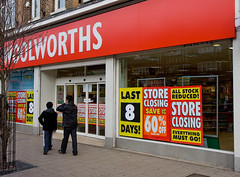Michael Jackson suffered a heart attack last night (European time), and could not be resuscitated. Wacko Jacko he may have been, but it’s the end of an era. Love or hate him or his music, he’s the biggest selling album artist of all time. His music, his pop videos and his dancing have influenced pop forever, just like the Beatles and Elvis before him. His collaborations with Paul McCartney (Say Say Say, The Girl is Mine) are among my favourites.
I had a copy of Thriller on vinyl, and I’ll always remember the day I was at Auntie Val’s and we put on the first side. The needle dropped on the record and “Wanna Be Startin’ Something” started up… I must have been about 8 years old at the time. There goes another part of my childhood.
[update] There are a few articles around now that are covering the story of Michael’s life and death with a bit more depth; notably the Guardian’s Hadley Freeman with “This is not a Diana Moment” and an excellent article over at Urban Semiotic, “The Veneration of Michael Jackson begins“. As for the cause of death (direct or indirect) news is emerging that he may have been addicted to Demerol or Morphine.
Image credit: stylespion





